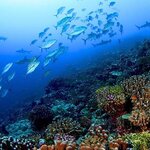Oceanography

SAR11 are the most abundant plankton in the world's oceans. They are also a massive source of two sulfur gases that play important roles in the Earth's atmosphere.
Many types of gaseous fumes emerge from the ocean, such as formaldehyde, acetone and methanol, but the researchers behind a new study say they were very surprised that the cells under scrutiny produced both dimethylsulfide - DMS - which we recognize as the smell of the sea, and methanethiol, the smell of which makes us think of leaking gas lines.
The
dimethylsulfide
is made by a newly discovered gene, according to the…

Sea-level rise, erosion and coastal flooding are some of the greatest challenges facing humanity from climate change.
Recently at least five reef islands in the remote Solomon Islands have been lost completely to sea-level rise and coastal erosion, and a further six islands have been severely eroded.
These islands lost to the sea range in size from one to five hectares. They supported dense tropical vegetation that was at least 300 years old. Nuatambu Island, home to 25 families, has lost more than half of its habitable area, with 11 houses washed into the sea since 2011.
This is the first…
Coral reefs and hard-shelled sea creatures such as oysters and mussels are constantly being threatened, not only by the detrimental effects of stressors such as climate change and habitat loss, but also by microorganisms.
Researchers have discovered how a particular type of cyanobacteria, a photosynthetic microbe, is able to bore into and live within solid carbonates, the main mineral that makes up coral skeletons and seashells -- hastening their erosion and causing trouble for shellfish farmers.
Organisms that can do this, known as euendoliths, infest many kinds of rock, but they are…

Groundwater extraction and other land water contribute about three times less to sea level rise than previous estimates, according to a new study. Sea level has risen an estimated average 1.7 mm per year over the 20th and the early 21st century, and concerns are that will increase uif climate change further warms the planet.
Researchers have the rising seas to a combination of factors including melting ice caps and glaciers, thermal expansion (water expands as it gets warmer), and the extraction of groundwater for human use. Land water contributions are small in comparison to the contribution…

Coral reefs, the world's most productive and diverse marine ecosystems, rely on a recycling program to stay healthy: The corals and algae that form the base of the reef's food web release a variety of nutrients that support a complex and efficient food chain.
But when this system gets out of whack, the cycle breaks down and endangers the coral reef's health, and a new paper in Nature Microbiology explores how a process known as "microbialization" destroys links in this delicate food chain.
Millions of people around the world depend on coral reefs to provide productive fisheries. Overfishing…

Vanishing Arctic sea ice, dogged weather systems over Greenland, far-flung surface ice melting on the massive island - these trends and global sea-level rise are linked by climate change, according to a new paper.
During Greenland summers, melting Arctic sea ice favors stronger and more frequent "blocking-high" pressure systems, which spin clockwise, stay largely in place and can block cold, dry Canadian air from reaching the island. The highs tend to enhance the flow of warm, moist air over Greenland, contributing to increased extreme heat events and surface ice melting, according to the…

Current climate models are too simplistic to really account for all of the factors in climate in the present, much less predict the future, but they are being used by policy makers to anticipate the effects of greenhouse gases as far out as a hundred years so it is important they gradually converge on accuracy before too much money is spent.
Today, at the Microbiology Society's Annual Conference, scientists discussed one missing piece of the puzzle in computer simulations - Arctic microbes that are increasing the rate at which glaciers melt.
The research, led by Dr Arwyn Edwards from…

Scientists have developed a mathematical model to derive the probability of extreme waves. This model uses multi-point statistics, the joint statistics of multiple points in time or space, to predict how likely extreme waves are.
The results, published today, Friday 11 March, in the New Journal of Physics, demonstrate that evolution of these probabilities obey a well-known function, greatly reducing the complexity of the results.
"It's common in science and engineering to consider noise and fluctuations as something we need to avoid or eliminate in order to gain the best results" explains…

While there is speculation and numerical estimates about what might happen to Antarctica's nation-sized Ross Ice Shelf in a warming climate, oceanographers have a good idea of what happened to a 100,000-square-mile section within 1,500 years after the last Ice Age ended.
The Ross Ice Shelf is a vast floating extension of the West Antarctic Ice Sheet, about the size of France, and the world's largest ice shelf. But it was once much larger, extending farther north and covering the entire Ross Sea. The present Ross Ice Shelf is about 500 miles wide and several…

Ancient records tell us that the intrepid Viking seafarers who discovered Iceland, Greenland and eventually North America navigated using landmarks, birds and whales, and little else. There’s little doubt that Viking sailors would also have used the positions of stars at night and the sun during the daytime, and archaeologists have discovered what appears to be a kind of Viking navigational sundial. But without magnetic compasses, like all ancient sailors they would have struggled to find their way once the clouds came over.
However, there are also several reports in Nordic sagas and other…